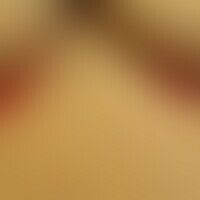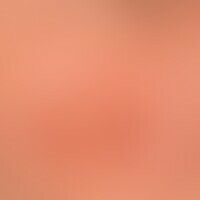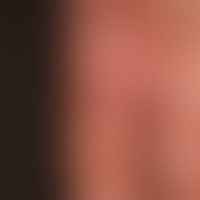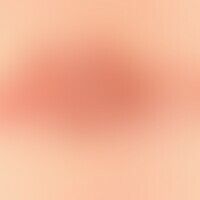Image diagnoses for "Plaque (raised surface > 1cm)"
570 results with 2865 images
Results forPlaque (raised surface > 1cm)

Lichen sclerosus (overview) L90.4
Lichen sclerosus et atrophicus: Severe perianal and vulvar infestation with speckled pattern of sclerotic and atrophic areas.

Pityriasis rosea L42
Pityriasis rosea: clearly visible primary medallion in the right axilla. the red colour typical of the flock in white skin is completely absent in dark skin.

Inverted psoriasis L40.83
Psoriasis inversa: 69-year-old woman. 6 months at presentation. no manifestations of psoriasis present on the remaining integument. family history but positive: son with known psoriasis vulgaris.

Cutaneous mastocytoma Q82.2
Mastocytomas, cutaneous: moderately consistency-propagated, brownish-reddish, blurred, maculopapular plaques; the Darian sign is positive (development of a wheal after rubbing the efflorescence).

Lupus erythematosus subacute-cutaneous L93.1
Lupus erythematosus, subacute-cutaneous, multiple, chronically dynamic, increasing, small or extensive red spots as well as red, small, sometimes rough, scaly papules and pustules on the face of a 66-year-old man. Furthermore, extensive, net-like branched telangiectasia can be found. DIF from lesional skin (see inlet; arrows indicate IgG deposits on the dermo-epidermal basement membrane zone and the follicular epithelium)

Crusted Scabies B86.x1
Scabies norvegica: Severe, generalized, untreated scabies of the whole integument with flat, psoriasiform scaly crusts at the back of the head; broad perilesional erythema.

Mucinosis cutaneous (overview) L98.5
mucinosis(s). plaque-shaped, idiopathic, cutaneous mucinosis. red, rather sharply defined, cushion-like, smooth plaques in the face of a 42-year-old woman. similar efflorescences were observed in the breast area and on the back.

Lichen planus mucosae L43.8
Lichen planus mucosae: flat, verrucous lichen planus of the oralmucosa; considerable burning discomfort when eating acidic food and drinks.

Bowen's disease D04.9
Bowen's disease: Sharply bordered brownish plaque that has existed for 2 years, is completely asymptomatic, sharply bordered and brown in colour.

Lichen planus mucosae L43.8
Lichen planus mucosae: less symptomatic white plaques in exanthematic lichen planus of the skin.

Acrodermatitis continua suppurativa L40.2
Acrodermatitis continua suppurativa: chronic, recurrent, sterile pustular disease of the acromion, which leads to atrophy and loss of nails if it occurs repeatedly and persists for a long time (see figure).

Nevus verrucosus Q82.5
Bilateral naevus verrucosus in an infant. No symptoms. Psoriasiform aspect of the plaques running in the Blaschko lines, scattered, reddish, slightly infiltrated, scaly.

Necrobiosis lipoidica L92.1
Necrobiosis lipoidica: different clinical sections. frontal, large, little indurated, slightly reddened plaque with atrophic surface. lateral a 3.5 cm diameter medal-shaped plaque with a slightly marginalized edge.

Facial granuloma L92.2
Granuloma faciale: Red-brown, blurred and irregularly configured, symptomless plaque in a 52-year-old man. distinct follicular prominence. no known secondary diseases, no medication anmnesia. the finding has been present for several months and is slowly progressive. detailed picture of multiple plaques in the face.

Callus (overview) L84
Callus: circumscribed pressure callus in diabetic polyneuropathy; extensive erythema of the sole of the foot in insulin-dependent diabetes mellitus.

Angiokeratoma circumscriptum D23.L
Angiokeratoma circumscriptum, large confluent angiokeratomas in the area of the foot with cavernous transformation.

Erythroplasia queyrat D07.4
DD Erythroplasia: Balanitis plasmacellularis: For 1.5 years recurrent, in the meantime also healing, multiple, temporarily burning, red, rough, sharply defined, velvety granulated plaques on the glans penis in a 53-year-old patient. slight urinary incontinence.

Acrodermatitis chronica atrophicans L90.4
Acrodermatitis chronica atrophicans: extensive, oedematous, tender red erythema as well as flaccid atrophy with cigarette-paper-like folding of the skin on the right hand of a 77-year-old woman. For 2 years there has also been joint pain in both hands and both shoulder joints as well as gait insecurity with proven neuroborreliosis. The fingernails are partly dystrophic (see stripy leukonychia) and partly no longer firmly connected to the nail bed.

Squamous cell carcinoma of the skin C44.-
Squamous cell carcinoma of the skin: ulcerated, temporarily painful and burning, erosive plaque on lichen sclerosus et atrophicus, which has been present for years (still clinically detectable).

Squamous cell carcinoma of the skin C44.-
Squamous cell carcinoma of the skin: carcinoma of the nail bed, which was misjudged as a fungal disease of the toenail and whose infiltrating growth had led to an almost complete onychodystrophy.




